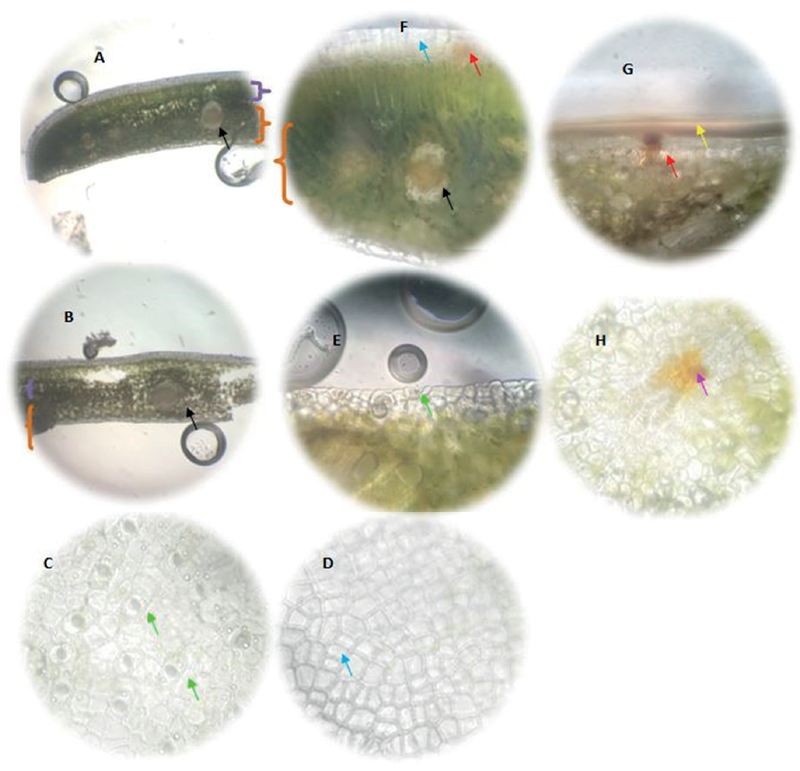Anatomy and Morphological Study of Mentigi Gunung (Vaccinium varingiaefolium (Blume) Miq.) in Area of Mount Batok-Indonesia
DOI:
https://doi.org/10.18502/kls.v3i4.685Abstract
Mentigi Gunung (Vaccinium varingiaefolium (Blume) Miq.), endemic plant of Java which dominates sub-alpine area of Mount Batok. This study aimed to characterize plant’s anatomical and morphological structure for conservation purpose. Microscopic and macroscopic approaches used for organs observation. Morphological observation showed that this plant has a tap root, circular stem with lenticels on its surface. It has red young stem with a lot of trichomes, brown old stem, oval leaves with integer margins. Leaves have stone cells, cuticles, idioblasts. Young leaves are red and turn green. Flowers are purple with five sepals, five petals, 10 androecium and one syncarp gynoecium. Trichomes spread all over flower structures. The type of microspore is tetraeder. The gynoecium sits on the receptacle composed of five carpellum with inpherus ovulus. The fruits are green, globular, with trichomes and turn black when ripe. It has stone cells with purple cytoplasm and golden brown seeds. Vascular bundle is opened collateral type; the type is parasitic with kidney-shaped guard cells.
Keywords: Anatomy; morphology; mentigi gunung; Vaccinium varingiaefolium (Blume) Miq.
References
NC. Devi, S. Aminah, and H. Taufikurahman, “Ecological aspects of vaccinium varingiaefolium growing in a stressed volcanic environment,” in Presented in Botany Conference, pp. 34–35, Bandung, ITB, 2001.
M. Heads, “Ericaceae in Malesia: vicariance biogeography, terrane tectonics and ecology,” Telopea, vol. 10, no. 1, pp. 311–449, 2003.
B. Hidayat Estiti, Anatomy tumbuhan berbiji [Anatomy of seed plant], ITB Press, Bandung, 1997, 4253 in Bahasa Indonesia.
Gembong. Tjitrosoepomo, “Morfologi tumbuhan: cetakan ke-17 [Plant Morphology],” Yogyakarta: UGM Press, pp. 4–251, 2007, in Bahasa Indonesia.
A. Sadili, R. Kartawinata, A. Kartonegoro, H. Soedjito, and A. Sumadijaya, “Floristic composition and structure of subalpine summit habitats on MT. Gede-Pangrango Complex, Cibodas Biosphere Reserve,” in Sumadijaya A. Floristic composition and structure of subalpine summit habitats on MT. Gede-Pangrango Complex, vol. 12, pp.
–404, Indonesia. Reinwardtia, West Java, 2008.
ER. Sakdiyah and RA. Kodir, Studi awal kandungan antosianin pada buah cantigi ungu (Vaccinium varingiaefolium (BL.) MIQ.) yang berpotensi sebagai suplemen antioksidan Preliminary studies on the anthocyanin content Cantigi purple fruit (Vaccinium varingiaefolium (BL.) Miq.) Potential as an antioxidant supplement. Prosiding SnaPP 2012: Sains, Teknologi dan Kesehatan 2012; 3: 95–100 in Bahasa Indoensia.
E. Susetyoadi Kartini, M. Saptasari, and Sulisetijono., “Anatomi tumbuhan [Plant anatomy],” in Anatomi tumbuhan [Plant anatomy], p. 41, UM Press, Malang, 2005, in Bahasa Indonesia.
SA. Suryani and D. Ratnawati, “Stomate response and transpiration rate of Vaccinium varingiaefolium (Bl.) Miq. leaf according to leaf development levels and distance ranges from sulphur gases source Sikidang cauldron Dieng Plateau,” Yogyakarta: MIPA UNY, pp. 1–12, 2003.
D. Sastramiharja and A. Siregar, “Fisiologi Tumbuhan [Plant physiology],” in Fisiologi Tumbuhan [Plant physiology], p. 34, Departemen Pendidikan dan Kebudayaan, Jakarta, 1996, in Bahasa Indonesia.
W. Prawiranata, S. Harran, and P. Tjondronegoro, “Dasar-dasar fisiologi tumbuhan,” jilid 1 [Basic of plant physiology, vol. volume 1], p. 138, 1991, in Bahasa Indonesia.
M. Jovančević, J. Balijagić, N. Menkovič et al., “Analysis of phenolic compounds in wild populations of bilberry (Vaccinium myrtillus L.) from montenegro,” Journal of Medicinal Plants Research, vol. 5, no. 6, pp. 910–914, 2011.
W. Chu, S. Cheung, R. Lau, and I. Benzie, “Bilberry (Vaccinium myrtillus L.),” in Herbal Medicine, vol. 20115386 of Oxidative Stress and Disease, pp. 55–71, CRC Press, , 2011.

